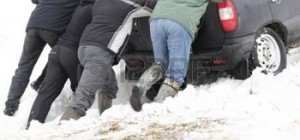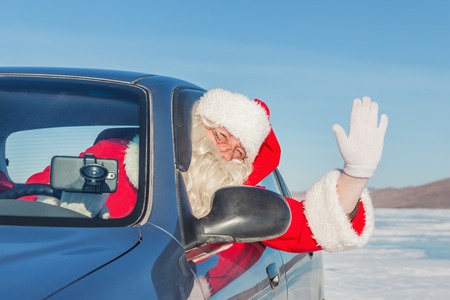Keeping your car in tip top condition should be something that you do all year round, however in winter, it’s really important to make sure that you are prepared. Nobody wants to get stranded in sub zero conditions.
This guide covers the following topics:
- Winter motoring checklist
- Setting off
- Driving in snow and ice
- Driving in heavy rain and floods
- Driving in high winds
- Flat battery
- Fuel
- Breakdown
Winter Motoring Checklist
When winter approaches, we should all carry out some basic checks to ensure that our vehicles are fit and ready to cope with winter conditions. Not being prepared could not only mean breaking down in bad weather but could also make it unsafe to be on the road.
- Check your battery
If your car has been stood still for a long period or your battery is getting old, it may well need charging properly before you head off on a trip.
- Check all exterior lights
Make sure that all lights are working properly and change any bulbs that are faulty including fog lights. Winter weather leads to much darker conditions and poor working lights could put your life at risk.
- Check wiper blades are in good working order
Wiper blades are essential in bad weather and it is easy to damage them when removing them from an icy windscreen. Damaged wiper blades will not clear your screen properly whilst you are driving and in bad conditions this could be very hazardous.
- Oil check
Make sure that you have the correct grade oil in your car and that levels are right.
- Anti-freeze/coolant
Check that coolant levels are correct and add anti-freeze. There is a risk of the engine freezing otherwise and this can be very costly.
- Tyres
Worn tyres won’t hold the road aswell if the conditions are wet or icy. Look for bulges, splits and cracks. Check the pressures with your handbook or in the door jam of your car.
- Screenwash
Check your washer bottle levels and add a winter addative to ensure that it doesn’t freeze. If you don’t use a screen wash which is graded for the likely temperatures that you will experience in your area, then your washer pump could freeze causing damage to fuses.
Setting off
Before setting off, it’s a good idea to make sure that you have packed a few essential and additional items just incase……
Have a spare set of warm clothes, boots and a blanket packed in the boot.
Check batteries on your torch and have it handy.
Make sure that you have an ice scraper and/or antifreeze.
Check your first aid kit.
Pack jump leads and a reflective warning sign.
Pack a shovel if it is snowing or icy. In particularily bad snow, think about snow shoes and chains.
Make sure that your phone is fully charged, and carry an in car charger.
Sunglasses – snow can give off a large amount of glare.
Planning is key.
Try to plan your journey in advance. Check the weather reports online so that you can be prepared for the worst. Know what likely conditions you may encounter and where there may be the most adverse conditions.
Let somebody know where you are going and an estimated time of arrival so that you will be missed if you don’t arrive.
Go through your winter car check list and make sure that you have enough fuel to get you to where you are going, or at least to a petrol station which you know will be open.
Driving in snow and ice
Ice and snow are two of the most treacherous road conditions. Black ice can be especially dangerous as you often can’t see it.

Think about changing your tyres for winter tyres which have a deeper tread if you live in an area where you are expecting a lot of snow or ice and ensure that your screenwash and coolant are safe down to -35 degrees.
Make sure that you allow adequate time before setting off to clear all windows and mirrors properly. Also ensure that you have cleared all snow from the top of your car if it has been parked outside, otherwise it could fall onto the windsreen, obscuring your vision if you should need to brake sharply.
Only drive if it is entirely necessary.
Driving
Accelerate gently and change gear upwards at the earliest chance. Staying in lower gear will cause the wheels to slip.
Think about stopping distances and make sure that you allow around 10 times the usual space.
Steer into a skid. Do not take your hands off the wheel or brake hard, this will only exacerbate the problem. Instead, go with the car, if it is veering right, steer right.
Be aware that compressed snow, that has been driven on by many other vehicles will likely be very slippery and now be ice.
Keep your speed down, change gear and brake slowly to avoid skidding.
Hail
Hail storms can damage your car and if you chose to get out of the vehicle, injure you.
If you should encounter a really bad hail storm, try to stay in the car. If necessary, pull over ,wait for the storm to pass and point your car bonnet forward in the direction of the hail. Car winscreens are reinforced and will withstand a beating from a hail storm, much better than the paintwork.
De-icing your car
Make sure that you completely clear any ice or snow from your windscreen, lights and mirrors. It is hazardous and will obstruct your view in already treacherous conditions to not do it properly.
Allow anough time and use a scraper or de-icer. DO NOT use boiling water as this could crack the glass. If you must use water, then luke warm, although bear in mind that any additional water applied to the windscreen could then freeze as you are driving.
De-icer can be applied to locks to free them.
Driving in heavy rain and floods
If at all possible, try to avoid venturing out in flooded areas. Driving in heavy rain or on flooded roads can be extremely hazardous and can also damage your car.
Try to plan your journey to avoid areas where rain will have settled and there could be a risk of flooding.
Make sure that your wipers are working properly and that you have enough fuel for your journey. Flooding and bad weather can cause delays and sitting in traffic uses more fuel that being at a constant speed.
Driving
- Use dipped headlights so that other drivers can see you more easily and DO NOT use fog lights.
- Think about increasing your stopping distances and reducing your speed.
- Watch out for spray from the roads which could obscure your vision from other vehicles. Especially larger trucks and fast moving vehicles.
- If you feel the car aquaplanning, ease off the accelerator and pump the brake. DO NOT brake hard, this will only lock the wheels and cause the car to slide further out of control. Reduce your speed.
- Try not to drive through deep water and if you have to then drive slowly, otherwise you may cause damage to your engine. Try not to stop at a stand still in the water and keep to the highest point of the road.
- Do not attempt to drive through fast flowing water.
- If you do brake down, keep the bonnet closed to avoid gettng even more water into the electrics. Turn off the engine and call for help.
- Test your brakes fully before continuing after driving through flood water.
For more detailed information of flood damaged vehicles, please take a look at our comprehensive guide.
Driving in high winds
When driving in high winds, be wary of towing vehicles as they could sway across the road. Watch out too for vehicles carrying items which may not be strapped down properly and could come loose. Try not to use roof racks or roof boxes and watch out for debris on the road or flying through the air.
Drive slowly as this will improve the car handling and try to stick to more sheltered areas. Y0u could encounter very powerful and high gusts when exposed.
Hold the wheel firmly.
Make sure that you are doubly careful of high sided vehicles…lorries and buses, motorcyclists and cyclist who may get caught with a gust and swerve into the road.
Avoid parking your car under trees and other areas where high winds could cause things to fall on it..or you.
Flat Battery
Cold and damp can play havoc on batteries. Think about checking your battery and charging it if necessary during the winter months.
Remember to switch off all lights, (incuding interior ones), heaters and wipers when switching your engine off to prevent the battery from draining.
Try not to leave sat navs, car chargers and other devises which put an additional drain on the battery, plugged in.
Carry a set of jump leads or a car jump pack with you, especially if your battery is more than three years old.
Fuel
Try to ensure that your fuel tank is always full or has enough for the journey that you have planned. Bear in mind that adverse weather conditions can cause traffic jams and hold up and a stationary car with the engine running will be using more fuel than one which is at a constant speed.
At this time of year, especially around Christmas, there may well be closures at some petrol stations or shortages due to the busy period, and you could find yourself getting to your planned fuel stop and it is closed. Check in advance which ones are open if you are going to need to stop for fuel and plan your journey accordingly.
Breakdown
Always ensure that you have a charged mobile phone with you when driving in adverse conditions. If you are unfortunate enough to break down then you will be able to phone for assistance and let someone know where you are. If possible, make sure that you also carry a charger.
Try to be aware of your location so that you are able to tell the recovery expert exactly where you are, You can do this by reading the signs at at the side of te road. For full details on how to read the road signs, please read our guide to using roadsigns to pinpont your location. Being able to pinpoint your location will greatly decrease the amount of time it will take to get you and your vehicle recovered and out of the cold.
